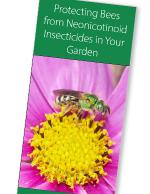As a science-based organization, the Xerces Society produces dozens of publications annually, all of which employ the best available research to guide effective conservation efforts. Our publications range from guidelines for land managers, to brochures offering overviews of key concepts related to invertebrate conservation, from books about supporting pollinators in farmland, to region-specific plant lists. We hope that whatever you are seeking—whether it's guidance on making a home or community garden pollinator-friendly, advice on developing a local pesticide reduction strategy, or detailed information on restoring habitat—you will find it here!
Find Publications
Use the search functions to sort by publication type (books, guidelines, fact sheets, etc.), location, and/or subject (agriculture, gardens, pollinators, pesticides, etc.).
The Florida Museum of Natural History, in collaboration with the Xerces Society, the Butterfly Conservation Initiative, and the U.S. Forest Service, has produced three educational brochures that feature information about monarchs and milkweeds. One side of the brochure describes the plight of the monarch and encourages the planting of regionally appropriate milkweed species, while the second side showcases larvae of other butterfly species and their associated host plants.
The Florida Museum of Natural History, in collaboration with the Xerces Society, the Butterfly Conservation Initiative, and the U.S. Forest Service, has produced three educational brochures that feature information about monarchs and milkweeds. One side of the brochure describes the plight of the monarch and encourages the planting of regionally appropriate milkweed species, while the second side showcases larvae of other butterfly species and their associated host plants.
Neonicotinoids are a group of insecticides that are used widely on farms, as well as around our homes, schools, and city landscapes. This brochure explains why they are a risk to bees, gives examples of neonicotinoid garden products, and gives some simple tips for protecting bees from these insecticides
To see the full list of brochures available for download, click here.
Native thistles are wildflowers within the genus Cirsium. They occur in a broad range of habitats—pastures, grasslands, prairie remnants, roadsides, idle fields, open woodlands, savannas and wetlands—where they play a vital role in ecosystems. This brochure describes native and non-native thistles and provides guidance on recognizing the different species and their distinct features.
Habitat for Predators and Parasites
This brochure illustrates how farmers can attract and retain helpful predators and parasites by providing some of the key resources that they require.
Las Abejas Nativas y Sus Cosechas
A Spanish translation of the brochure Farming for Pollinators.
Este folleto proporciona un resumen de los requisitos de hábitat de los polinizadores de cultivos y su hábitat se puede encontrar en el área alrededor de una granja.
To see the full list of brochures available for download, click here.
Native Bees and Your Crops
This brochure provides a summary of the habitat requirements of crop pollinators and where their habitat may be found in the area around a farm.
To see the full list of brochures available for download, click here.
Guidelines for Planning, Preparation, Design, Installation, and Maintenance
Native meadows, filled with perennial wildflower mosaics and waving grasses, are growing in popularity with property owners and designers because they provide benefits to people, pollinators, and wildlife while demonstrating sustainability values. These meadowscapes offer economic and ecological advantages over intensively managed horticultural landscapes. Seeded meadows are low-input alternatives to containerized plantings or certain turf spaces, and so they have a role to play in institutional, commercial, and multifamily residential projects.
Printable Yard Sign
Join us as we participate in No Mow May! By leaving your property unmown for the month of May, you’re creating habitat for pollinators and other wildlife.








